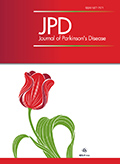Authors: Fanciulli, Alessandra | Leys, Fabian | Falup-Pecurariu, Cristian | Thijs, Roland | Wenning, Gregor K.
Article Type:
Review Article
Abstract:
Orthostatic hypotension (OH) is a common non-motor feature of Parkinson’s disease that may cause unexplained falls, syncope, lightheadedness, cognitive impairment, dyspnea, fatigue, blurred vision, shoulder, neck, or low-back pain upon standing. Blood pressure (BP) measurements supine and after 3 minutes upon standing screen for OH at bedside. The medical history and cardiovascular autonomic function tests ultimately distinguish neurogenic OH, which is due to impaired sympathetic nerve activity, from non-neurogenic causes of OH, such as hypovolemia and BP lowering drugs. The correction of non-neurogenic causes and exacerbating factors, lifestyle changes and non-pharmacological measures are the cornerstone of OH treatment. If these
…measures fail, pharmacological interventions (sympathomimetic agents and/or fludrocortisone) should be introduced stepwise depending on the severity of symptoms. About 50% of patients with neurogenic OH also suffer from supine and nocturnal hypertension, which should be monitored for with in-office, home and 24 h-ambulatory BP measurements. Behavioral measures help prevent supine hypertension, which is eventually treated with non-pharmacological measures and bedtime administration of short-acting anti-hypertensive drugs in severe cases. If left untreated, OH impacts on activity of daily living and increases the risk of syncope and falls. Supine hypertension is asymptomatic, but often limits an effective treatment of OH, increases the risk of hypertensive emergencies and, combined with OH, facilitates end-organ damage. A timely management of both OH and supine hypertension ameliorates quality of life and prevents short and long-term complications in patients with Parkinson’s disease.
Show more
Keywords: Parkinson’s disease, orthostatic hypotension, post-prandial hypotension, supine hypertension, nocturnal hypertension
DOI: 10.3233/JPD-202036
Citation: Journal of Parkinson's Disease,
vol. 10, no. s1, pp. S57-S64, 2020






